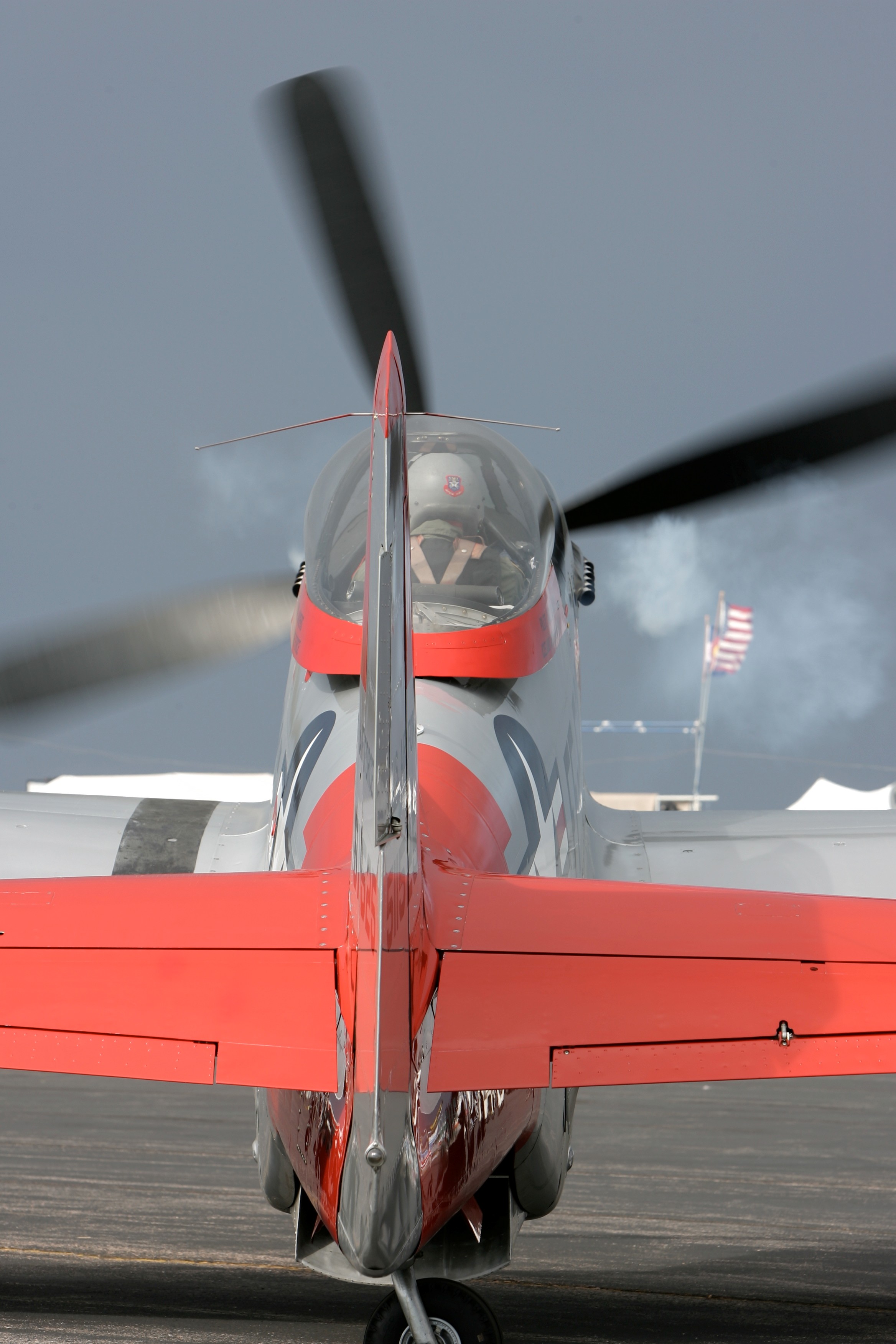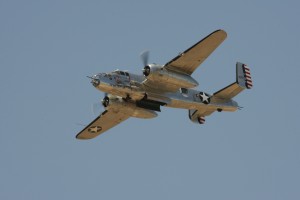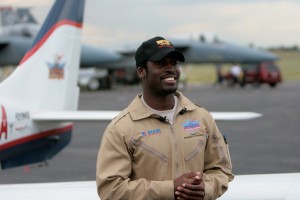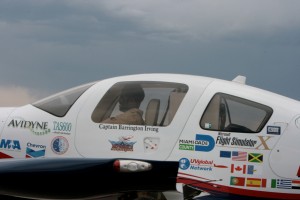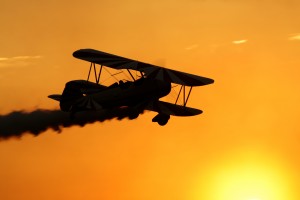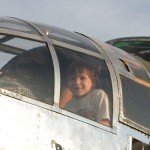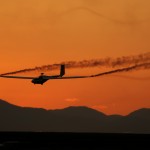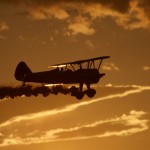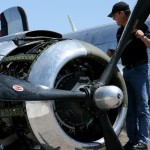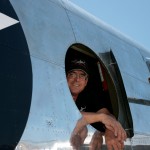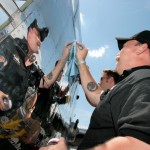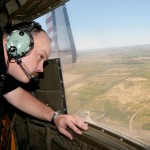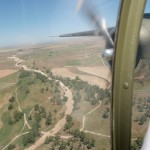By Reggie Paulk
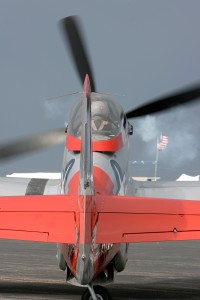
Maj. Gen. Bill Anders, former Apollo 8 astronaut, fires up his P-51, Val-Halla, for a maintenance hop.
The Rocky Mountain EAA Regional Fly-In officially took place June 22-24. However, for a lucky few, the fun began earlier in the week. On Monday, June 18, the B-25, Pacific Prowler, made its way to Front Range Airport (FTG) in Watkins and kicked off a week that would see records set on the ground and in the air.
Pacific Prowler
June 19 was media day for an airplane type that’s synonymous with The Doolittle Raid: the B-25 Mitchell bomber. Pacific Prowler saw combat in the Pacific Theater during the early years of World War II. Built in 1942, the airplane survived more than 150 combat missions before moving stateside to act as a VIP transport. After a long life as a photo and movie ship, a group in Texas rescued the aircraft to preserve her heritage.
Sitting alone on the main ramp at Front Range Airport, the lines of the polished aluminum beauty constantly changed from one vantage point to the next. From the unique twin tails to the four forward-facing machine guns below the pilot’s windows, the airplane exudes power. The fuselage is quite narrow for an airplane of this size, and the twin Wright Cyclone radial engines sit in their own huge pods. The B-25 sits very tall on its tricycle landing gear—high enough that a six-footer barely needs to duck to walk under it.
After admiring the airplane, media guests climbed aboard to take a ride. The B-25 has two belly doors, one forward and one aft. The forward hatch dropped, and a small ladder slid down to allow access. After climbing up through the narrow hatchway, green-painted, aluminum insulation and a large circuit breaker board greeted guests. Getting to some of the seats mounted above and behind the hatch required a little bit of gymnastics, but once seated, visitors had the opportunity to look around.
Looking forward toward the cockpit are red levers, including one that will retract the gear while the airplane is sitting on the ground—which is why it was important for passengers not to touch anything painted red! Once the pilots climbed aboard, they secured and placed a structural cover over the hatch, so it could be walked on during the flight. The airplane is a tight fit, just wide enough to seat two people side by side. Each passenger received earphones; their necessity became apparent shortly after the engines started.
The engine start was a combination of barking and popping exhaust notes and heavy vibration. Those big propeller blades have a lot of inertia to overcome, and the engines have to work hard to get started. Once the airplane was idling, it dawned on some that they were seated almost directly between those propeller blades. The noise was already deafening and the airplane hadn’t even begun to taxi.
The B-25, a tricycle gear plane, handled nicely on the ground and quickly made its way to the run-up pad. Once there, the power came up and the mags and systems were checked. In this airplane, passengers can actually hear the reduction in rpm as the magnetos are cycled through on each engine.
Takeoff was powerful. The Wright Cyclone engines on this plane each have 14 cylinders and produce 1,700 maximum horsepower. With no bomb load and only human cargo, the airplane rapidly approached and then exceeded flying speed. The noise at that point, even with earphones, was deafening as the airplane headed uphill quickly.

Barrington Irving signs an autograph for an admiring fan. He’s unofficially the youngest person ever to fly solo around the world and is the first of African descent to do so.
Once airborne, the go-ahead was given for guests to move freely about the cabin. Getting through the narrow passageway to the nose gunner’s position was difficult, but rewarding. Plexiglas all around made for a spectacular view; the world moved by like an IMAX movie.
Part of the wonderful experience of flying in Pacific Prowler is the crew. Pilots Jim Terry and Steve Swift, along with chief mechanic Joe Ranson, were always doing some sort of maintenance to their bird. Polishing aluminum or removing a cowling, they’re constantly at work. Only after the sun dipped low on the horizon and the evening beckoned did they wash the grease off their hands and relax.
Barrington Irving
While not originally scheduled to appear at the fly-in as part of his world tour, Barrington Irving couldn’t have timed his arrival to Denver any better. He flew into Front Range Airport on June 21.
At 23, Irving is unofficially the youngest person ever to fly solo around the world and is the first person of African descent to do so. After setting off from Miami on March 23, he encountered many weather-related delays that pushed back his Denver arrival more than two months. The arrival of his Columbia 400 was greeted with much anticipation; there was electricity in the air as he closed on the airport.
The PA system was tuned to the tower frequency, and Irving could be heard conversing with the controllers as he approached the airport. News crews, Tuskegee Airmen, friends and fans awaited his arrival. After his airplane appeared overhead, he headed for the active runway for a high-speed pass.
The turbulence and winds were especially challenging, so Irving took it easy as he pulled up at the end of the runway to come back around to land. The excitement grew as he taxied in and photographers and video crews clamored for good vantage points.
A multitude of people greeted the pilot after he shut down his aircraft. His stop in Denver was special; he wasn’t coming through just for a visit—this was an official stop on his record attempt. Everyone present was a part of history in the making.
A show to remember
For pilots wanting the fly-in all to themselves, Friday was the day to arrive.
“Adding Friday was an exciting new addition to the fly-in this year,” said Jim Cimiluca, fly-in director. “We now have a day to exclusively accommodate pilots.”
This year’s addition proved its value. Officially, the air show began on Saturday, but for pilots, the fun started one day earlier. Performers were able to practice routines, and they could check out planes and visit other pilots without swarms of people around. In addition, Friday included a variety of forums, aircraft judging and a spectacular evening air show topped off with the Barnstormer’s Ball, a VIP event with music and WWII period costumes.
The daytime air show routines, taking place Friday through Sunday, were spectacular. Don Nelson kicked off the show in his Sukhoi 26 followed by Gary Rower in his Stearman and then Randy Harris in his brightly colored Steen Skybolt biplane. The West Coast F-15 demo team, based at Eglin Air Force Base, Florida, created its own thunder, as Capt. Tony “Baron” Bierenkoven punched the afterburners and went vertical.
On the flight line, the Colorado Air National Guard parked an F-16 for static display after the pilot did a high-speed flyby, cranking and banking before landing. Rob Duncan parked his TBM Avenger on the ramp for display as well, after an impressive arrival. After landing, he folded the big wings of the Avenger so he could maneuver more safely on the ramp. After positioning the huge airplane, he unfolded the wings again, providing a spectacle for all who were present.
As the afternoon wore on, a huge windstorm blew in, and microbursts could be seen on the horizon. The wind picked up to the point that tents, chairs and anything not tied down began to blow away. Airplanes unfortunate enough to arrive during this time required wing walkers, but all of the volunteers present pulled off the recovery without a hitch. It seemed as if the weather might dampen the evening, but it was because of the weather that spectators were treated to the most beautiful sunset in RMRFI history.
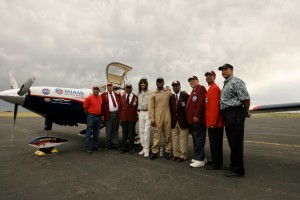
Barrington Irving visited with Joe Jones, RMRFI art director, and members of the Tuskegee Airmen. L to R: Gilbert Wheeler, Maj. James Harrison, Col. John Mosley, Jones, Irving, Col. Fitzroy “Buck” Newsum, Norvell Simpson, Ron Hilliard and Willy Daniels II
The weather died down after about an hour. Rower fired up his Stearman for an evening performance par excellence. With the setting sun turning the cloud cover and his air-show smoke a blazing orange, he looped, rolled and dove in a dazzling display of beauty. As Rower finished his performance, Bob Carlton fired up his twin turbojet-powered glider for another jaw-dropping performance. Powered by two coffee-can sized jet engines, the glider took off under its own power and climbed for altitude before beginning the routine. In the late afternoon, the smoke canisters on the wingtips could be seen throwing sparks as they were lit. Trailing twin tails of smoke, Carlton looped and rolled, the smoke forming into swirling ribbons. Spectators could barely hear the miniature jet engines in the still air.
After the sun had set on Friday night, the Barnstormer’s Ball was the place to be. With swing music playing in the background, courtesy of “Hot Tomatoes,” members of the military vehicle association showed up in WWII regalia and vehicles, adding a certain authenticity to the evening. Nearby, the crew of Pacific Prowler stood proudly around her, talking to visitors and answering questions.
The RMRFI also included a pancake breakfast on both Friday and Saturday (to raise funds for the Kiwanis Clubs of Jefferson County), an awards dinner on Saturday night and a ceremony to honor veterans on Sunday (Front Range Field of Honor). Young Eagles flights were provided as well as workshops for youth and adults, and forums and safety seminars.
For more information about RMRFI, including aircraft judging results, visit [http://www.rmrfi.org]. Next year’s theme is “Flying With Adversity,” and organizers are looking for stories of obstacles people have overcome to pursue their love of flying.
This piece is dedicated to the memory of air show announcers Herb Berkman and Terry Langen: The voices of the fly-in were silenced forever when their RV-6 crashed the day after the event concluded.
- A smiling young boy peers out from the nose turret of Pacific Prowler.
- Bob Carlton flies his jet-powered glider against a burning sky.
- The wings of Gary Rower’s Stearman glint with the setting sun.
- In the cockpit of his Stearman, Gary Rower awaits the go ahead for the evening air show.
- Pilot Jim Terry examines one of the ever-pesky engines on Pacific Prowler.
- Jim Terry relaxes on the aft side of Pacific Prowler.
- Mechanic Joe Ranson (foreground) and pilot Steve Swift perform the never-ending ritual of polishing the B-25 Pacific Prowler.
- Joe Ranson looks out the waist gunner’s window. One of the B-25’s twin tails is above him.
- Pacific Prowler passengers enjoyed this view from the right side of the nose turret position.
- Joe Ranson (left), Steve Swift and Jim Terry (background) pull the propeller through to check for hydraulic lock before flight.
- Randy Harris climbs out after his performance in his Steen Skybolt.
- Bob Carlton leaves silky tails of smoke as he performs in his turbo-jet glider during Friday evening’s show.
- F-15 Capt. Tony “Baron” Bierenkoven performs a low pass after takeoff during his performance.











